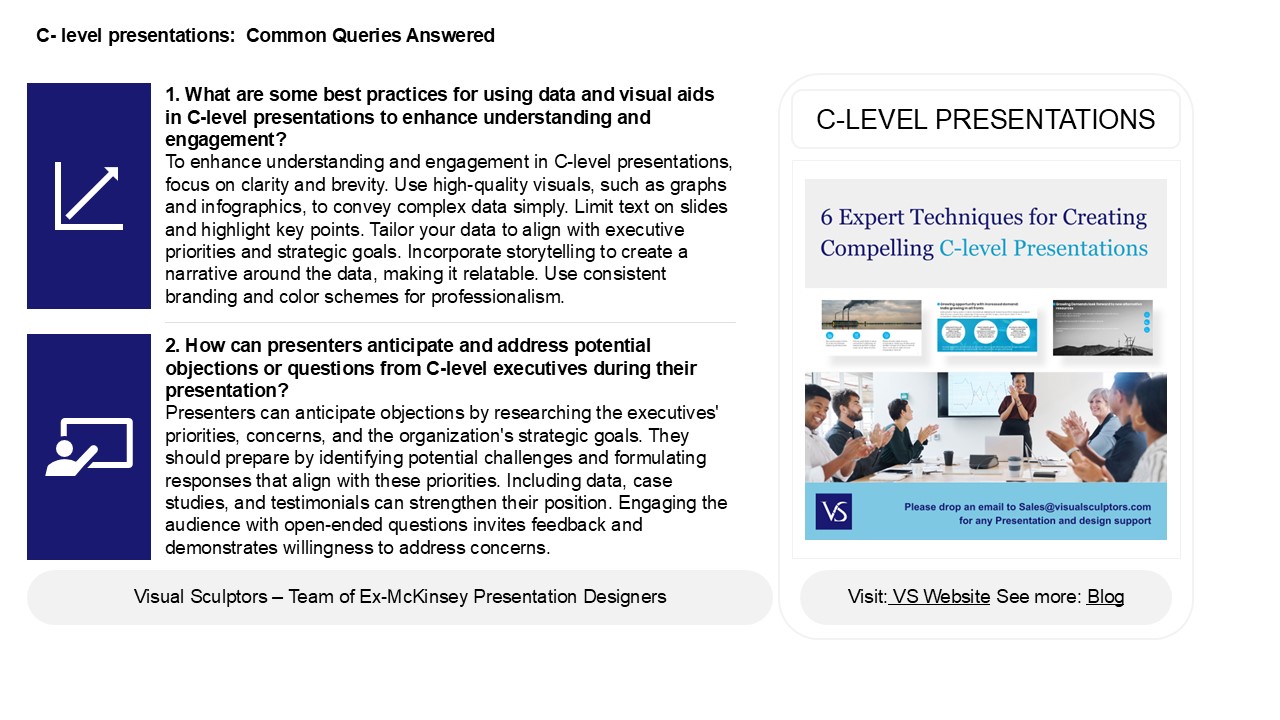Aligning Presentations with C-Level Goals and Objectives
Title:
Aligning Presentations with C-Level Goals and Objectives
Description:
When presenting to C-level executives, it's important to use effective data and visuals to enhance understanding and interest. Presenters should use clear and impactful visuals, like charts and infographics, to simplify complex information. Being prepared for questions and understanding the executives' priorities can help address concerns proactively. To keep the presentation focused, it's essential to prioritize key messages that align with overall goals. Additionally, handling questions well requires active listening and flexibility, fostering productive discussions. Using data and analytics is crucial, and presenting information clearly helps reinforce decision-making. –
Number of Views:0
Date added: 12 April 2025
Slides: 3
Provided by:
visualsculptors
Category:
How To, Education & Training
Tags:
Title: Aligning Presentations with C-Level Goals and Objectives
1
C- level presentations Common Queries Answered
1. What are some best practices for using data
and visual aids in C-level presentations to
enhance understanding and engagement? To enhance
understanding and engagement in C-level
presentations, focus on clarity and brevity. Use
high-quality visuals, such as graphs and
infographics, to convey complex data simply.
Limit text on slides and highlight key points.
Tailor your data to align with executive
priorities and strategic goals. Incorporate
storytelling to create a narrative around the
data, making it relatable. Use consistent
branding and color schemes for professionalism.
C-LEVEL PRESENTATIONS
2. How can presenters anticipate and address
potential objections or questions from C-level
executives during their presentation? Presenters
can anticipate objections by researching the
executives' priorities, concerns, and the
organization's strategic goals. They should
prepare by identifying potential challenges and
formulating responses that align with these
priorities. Including data, case studies, and
testimonials can strengthen their position.
Engaging the audience with open-ended questions
invites feedback and demonstrates willingness to
address concerns.
2
C level presentations Common Queries Answered
3. What techniques can be employed to ensure that
a C-level presentation remains concise and
focused while still conveying all necessary
information? 1. Outline Key Messages
Identify 2-3 core points to communicate
clearly.2. Use Visuals Leverage charts,
graphs, and infographics to convey data
quickly.3. Limit Slides Keep presentations
to 10-15 slides maximum.4. Practice Brevity
Use clear, straightforward language and avoid
jargon.5. Engage the Audience Allow time
for questions to clarify and deepen
understanding.
4. What techniques can be used to handle
questions and feedback from C-level executives
during or after a presentation? To handle
questions and feedback from C-level executives
effectively, employ active listening to
demonstrate respect and understanding. Maintain
composure and respond clearly and concisely,
focusing on strategic implications. Use visuals
to support your points and anticipate potential
questions to prepare responses in advance. Engage
them by encouraging dialogue, summarizing their
feedback, and expressing appreciation for their
insights. If unsure about an answer, acknowledge
it and offer to follow up later. Lastly, ensure
to keep the discussion aligned with their
priorities and the organization's goals to
maintain relevance and interest.
5. How important is the use of data and analytics
in C-level presentations, and what are best
practices for presenting complex information
succinctly? Data and analytics are crucial in
C-level presentations as they provide
evidence-based insights that drive strategic
decisions. Best practices for presenting complex
information succinctly include using clear
visuals like charts and graphs, focusing on key
metrics, and telling a compelling story that
connects data to business outcomes. Limit text on
slides, utilize the "one key message per slide"
rule, and practice delivering the content to
ensure clarity and confidence. Engaging the
audience with relevant examples and encouraging
discussion can also enhance understanding and
retention.































